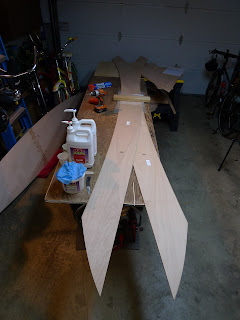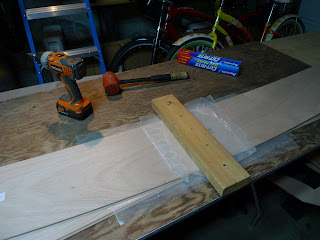Halloween Scarfing
- Day Two: 1 hour
- Total build time: 3 hours
Happy Halloween! Today, and the next few days are going to be relatively short ones. This is mostly because of the limited space I have available in my shop.
Before I could get started today I had to run to the store and pick up some acid brushes. I would have thought they would have been included in the kit, but they are cheap so it was ok to stock up. After trimming them back a bit they are perfect for applying the epoxy to the scarfs.
I pulled the weights off of the bottom panel and was pleased to see a good, strong joint. I was a little concerned because the finger style scarfs that CLC pre-cuts in all the panels are very tight, and I was worried that I may just push all the epoxy out of the joint as I slid (pounded) them together, and end up with a glue-starved joint. I guess this is not a big risk on the bottom panel because the bottom is sheathed in fiberglass anyway, but the side panels don't have that reinforcement. With typical wood glue you need a super tight joint for the glue to bond successfully, but with epoxy there needs to be enough glue to create a material gap-filling bond. I hope CLC knows what they are doing! I imagine they probably do, but don't make me get out that Moaning Chair!
I started scarfing up the strakes today, but because I only have room to do one matching pair at a time it is going to take me a few days to get through the three sets of them. Today was #1, the "garboard strake" in the parlance of boat building. Probably a misnomer since stitch and glue boat building is a completely different process than clinker planking, which is where that term comes from. Plank #1 is the one which attaches to the bottom panel, and it's the first one to give the boat it's beautiful, curving shape.
On to the snaps...
Preparing for glue-up
It is important that both strakes have the exact same profile, so during glue-up I "book-match" them, and clamp both scarfs at the same time so they have the same shape. Very interesting to think these long, swooping, flat planks are going to curve into the shape of a hull. So cool!
A simple piece of two by four screwed into the work bench makes a perfect clamp for both strakes at the same time.
The next few days will be more of the same, so I will batch the next group of scarfs into one post to save time. See ya in a few days!










